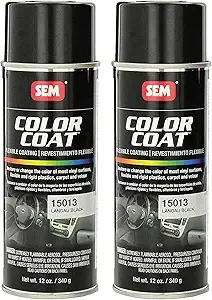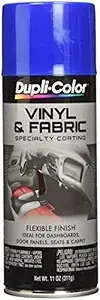When your car’s interior plastic trim looks faded, cracked, or just plain old, choosing the best paint for car interior plastic can make all the difference. Not all paints are created equal: you need something durable, flexible, and capable of bonding to plastic surfaces. Below, we’ll explore what to look for, some of the best paints you can buy, real user pros & cons, and how to apply them so they last.
What Makes a Great Automotive Interior Plastic Paint
Before diving into specific products, here are the key criteria:
- Adhesion / Primer or Adhesion Promoter: Plastic has low surface energy. You’ll often need a primer or something that helps the paint bond.
- Flexibility: Interior plastic expands, contracts, and flexes. If paint is too rigid, it will crack or peel.
- Durability & Resistance: UV, heat, friction, cleaning chemicals. Paint needs to resist all of these.
- Finish: Matte, satin, gloss , matching the factory sheen or your aesthetic.
- Ease: Of application & drying time.
In SEO terms, people look for “automotive interior touch up paint”, “automotive interior plastic trim paint”, “auto interior paint”, etc. Each of those implies slightly different uses , from small scratches to full trim refreshes.
Top Picks: Best Paints & Coatings
Here are several well-reviewed paints and coatings that stand out, each with its strengths and limitations. All are suitable (if used correctly) as best permanent paint for plastic, paint that will cover plastic, or best paint for automotive plastic.
1. SEM Color Coat (e.g. SEM 15013 Landau Black)
Pros:
- Fade-resistant, gloss or satin finish.
- Good flexibility and formulated for both rigid and flexible plastics.
- Many users report it blends well with factory interiors when matched using color codes.
Cons:
- It can be pricey compared to simpler spray or fabric/vinyl paints.
- Needs good prep, cleaning, degreasing, possibly scuffing or sanding, adhesion promoter if raw plastic is exposed. Without that, adhesion can be poor.
Best use: When you want a semi-professional or OEM-style finish across large panels, dashboards, trim, anywhere you want lasting results.
2. Dupli-Color Vinyl & Fabric Coating Spray Paint (HVP Series)
Pros:
- Self-priming with adhesion promoter built in, delivering a flexible finish.
- Dries relatively fast, and good for smaller jobs like seats, door panels, dashboards.
- Many colors are available.
Cons:
- Less “premium” looking than SEM when side by side. May have more texture or less depth.
- May be less long-lasting under heavy abrasion or UV unless top coated or protected with clear coat.
Best use: Touch ups, color changes of smaller interior plastic/vinyl parts, or when you want good value without OEM level cost.
3. Rust-Oleum Fabric & Vinyl Spray Paint
Pros:
- Excellent adhesion, won’t rub off, crack or peel according to the manufacturer.
- Good finish on non-metal surfaces , dashboards, vinyl seats, door panels.
- Widely available, usually at affordable price.
Cons:
- Finish tends to be flatter; limited gloss control. If you want factory gloss, may need a clear coat.
- Less color variety than some specialty automotive-only brands.
Best use: Simple refreshes, matching worn pieces, or where budget is a concern.
Comparing These to “Automotive Exterior Plastic Paint”
Many paint types labeled “automotive exterior plastic paint” are intended for bumpers or exterior trim, these may have different flex, UV stability, or pigments. They sometimes work inside, but often they are more rigid or designed for harsher outdoor exposure. In contrast, paints like vinyl/fabric coatings focus more on flexibility and wear resistance, which inside your car is just as important (especially for plastic trim that’s touched often).
Real Users: What They Say
From forums and Reddit:
- “I’ve used both SEM Color Coat and Duplicolor Vinyl and Fabric, both with excellent results. Prep work is what will make the difference.”
- Another shared that after using Dupli-Color vinyl/fabric and several thin coats with good masking and adhesion promoter, the painted surfaces held up well even with regular use and cleaning.
These reinforce the idea: the paint choice matters, but prep and application matter more.
Step-by-Step Guide: Using Best Paint for Car Interior Plastic
- Remove the part if possible: Easier to prep, mask, paint, and less likely to get overspray.
- Clean thoroughly: Soap, degreaser, then wipe with isopropyl alcohol or specialized “plastic/leather prep” solutions.
- Sand or scuff lightly: Use a fine Scotchbrite pad or 400, 600 grit sandpaper (very lightly) to give a surface the “tooth” for adhesion.
- Prime / Adhesion promoter: Especially important for raw plastic. Some paints include adhesion promoters; with others you must add them.
- Spray in thin, even coats: Several light coats are better than one heavy coat (prevents runs, sagging).
- Allow proper drying & curing time: Manufacturer’s instructions matter. Even if “dry to touch” is fast, full cure might take 24-48 hours or more.
- Seal if needed: Clear coat or protective spray (matte, semi, or gloss depending on finish) can improve durability, UV resistance.
- Maintain gently: Use mild cleaners. Avoid harsh scrubbing or chemicals that can degrade flexible coatings.
Choosing the Right Type for Your Situation
- Small scratches, scuffs , go with automotive interior touch up paint or vinyl/fabric sprays.
- Complete trim change or color matching interior panels , consider something like PPG automotive interior vinyl paint or SEM with a full set of color options.
- High-traffic surfaces (armrests, steering wheel surrounds) , prioritize flexibility, layer build, sealing, and durability.
Also, think about the finish sheen: too glossy can reflect glare, too matte may look flat or cheap.
Internal Links: More Painting Tips & Context
- Before painting plastic parts, it helps to know how to clean walls before painting, the same principle of removing dirt and grime applies to plastic surfaces. See how to clean walls before painting.
- Drying and curing are important for any paint job. If you’re repainting interior plastic, understanding how to make paint dry fast helps avoid dust and debris settling on wet paint.
- If you’re working around edges or tricky areas (dashboard seams or where plastic meets vinyl), the skills in best way to paint edges between wall and ceiling can offer analogous tips about masking and careful strokes.
Product Review Table: Strengths & Weaknesses at a Glance
| Product | Strengths | Weaknesses |
|---|---|---|
| SEM Color Coat (Landau Black, etc.) | Superior color matching, OEM feel, good flexibility | Cost, careful prep needed; finish may vary depending on sheen |
| Dupli-Color Vinyl & Fabric Coating (HVP Series) | Fast drying, decent flexibility, good adhesion, many color options | Less premium gloss; may need sealing in harsh use |
| Rust-Oleum Fabric & Vinyl Spray Paint | Cheap, decent coverage, good for quick fixes | Limited sheen control, less color variety; may wear faster under frequent friction |
Final Verdict: What’s the Best Paint for Your Needs?
If I had to pick one “best overall” option, it would be SEM Color Coat, because of its durability, color matching, and user feedback. But if cost is a concern, for smaller or less critical parts, Dupli-Color HVP or Rust-Oleum fabric/vinyl paints give great value and acceptable results.
If you want something more permanent, make sure you’re using best permanent paint for plastic that includes adhesion promoter, flexible formula, and sealing. That’s what separates a short-lived job from a long-lasting upgrade.
Suggested Products with Amazon Links
Here are some of the specific products mentioned, with Amazon links. As always, when you buy, check color match, finish, shipping to your country, etc.
- SEM Color Coat / Landau Black (12 oz aerosol) , SEM 15013 Landau Black Color Coat. Buy on Amazon
- Dupli-Color Vinyl & Fabric Coating Spray Paint, Flat Black (HVP106) , ideal for dashboards, door panels. Buy on Amazon
- Dupli-Color HVP102 Blue Vinyl & Fabric Spray , if you want something more colorful. Buy on Amazon
- Rust-Oleum Fabric & Vinyl Spray Paint (Flat Black, 11 oz) , good budget choice. Buy on Amazon
Summary: Key Takeaways
- The best paint: For automotive plastic and interior plastic is one that balances adhesion, flexibility, durability, and finish.
- Paint plus: Prep equals success. Clean, scuff, prime/adhesion promoter, apply thin coats, allow curing, seal if needed.
- Match the product to the use: touch-ups vs full trim work; low-traffic vs high-touch areas.
- Always test: In a small, inconspicuous area first to check adhesion, color, and finish.




Leave a Reply